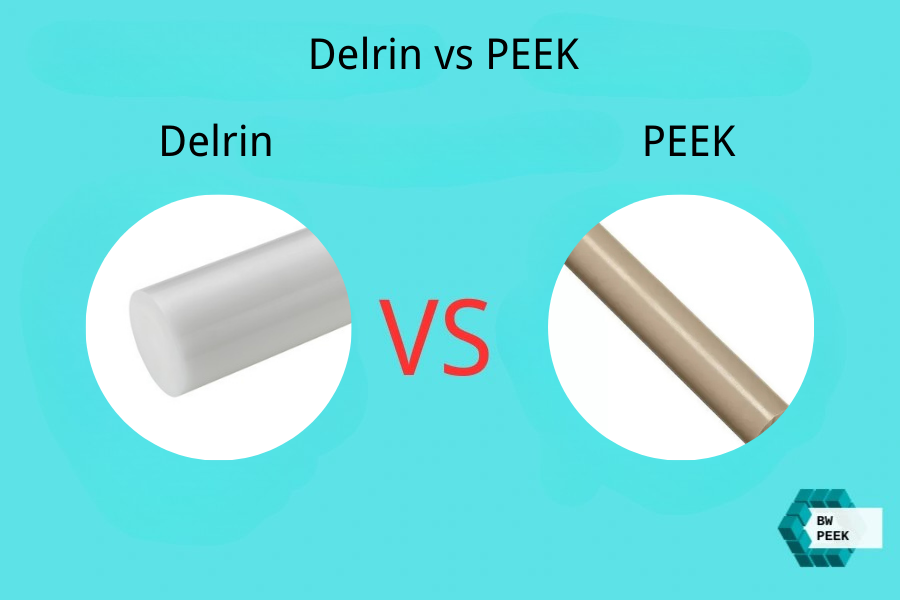


Both Delrin and PEEK are high-performance thermoplastics that are highly sought after in the field of engineering due to their high mechanical properties. They, however, do not perform well in extreme conditions like hot temperatures or when they are subjected to harsh chemicals. Sharp and deep articles present the main differences between Delrin and PEEK so that you can select the right material to use in your project. It is important to know when to use the economical advantages of Delrin or high strength of PEEK to maximise performance, combined with budgetary considerations.
Acetal or polyoxymethylene (POM or Delrin) is a low-friction thermoplastic that is strong and stiff. PEEK, by contrast, is a semi-crystalline aromatic polyketone thermoplastic that is characterised by high heat and chemical resistance. As you consider what material is the most appropriate to use, take into account that PEEK may be employed in a wide variety of industrial usage, but because of the properties it has, it is ideal in extreme conditions, unlike normal usages where Delrin may be used or any other plastic.
The Acetal homopolymer (delrin) is a well renowned dimensional stable substance invented by DuPont. PEEK is much newer, with its requirements being aerospace and medical device applications. The variations between Delrin and the PEEK are based on the chemical compositions of the two materials. The structure of Delrin is less advanced which gives it high machinability and low price and the complex aromatic nature of PEEK makes it have better heat and chemical resistance including strong acid and alkali resistance.
The low coefficient of friction and low cost are used to its advantage in gears, bearings, fasteners, and other automotive parts, all of which use Delrin. PEEK can be applied successfully in more difficult projects like aerospace seals, medical implants where biocompatibility is required and oil / gas valves where heat resistance and chemical inertness are needed. The most important differences are in the stresses the two, or more materials are capable of carrying. Delrin fits well in general mechanical components, but where high temperature or a corrosive atmosphere is involved, PEEK has to be used. In the end, these differences between PEEK and Delrin will ultimately allow you to select the optimum material.
In comparing both Delrin and PEEK, the mechanical property is a defining factor when it comes to applying them in certain operations. Silent plastic: Delrin (also called acetal or polyoxymethylene) is a stiff and strong material that exhibits a very good dimensional stability and low coefficient of friction. PEEK, however, demonstrates excellent mechanical strength and wear resistance, particularly under elevated temperatures, which makes it high-performance plastic and allows the utilisation in harsh environments. The variation in overall Delrin and PEEK can be seen when type Elasticity (high-load) and when type Delrin perform better in low-friction conditions (Delrin machining), PEEK is not applicable.
Important key differences exist in the thermal behaviour of Delrin vs PEEK, that affect high-temperature application suitability. Delrin can usually be used continuously at temperatures of 85 -100C and thus can be used in moderate thermal conditions. PEEK, on the contrary, has excellent heat resistance and still retains its heat-related mechanical properties at a high temperature up to 250 C and beyond. This Delrin to PEEK disparity is a major factor when choosing thermoplastic for components with high heat states, including those in aerospace or other industrial field uses where PEEK naturally has a high heat and chemical tolerance.
Chemical resistance of Delrin and PEEK differ significantly and affect the way of their usage in various chemical conditions. PEEK can be used in industries that have harsh chemicals as it is highly resistant to a wide range of chemicals such as alkali and strong acids. Delrin is not soluble in most solvents or fuels; however, it is not as stable to degradation by strong acids and oxidizers because it does not have polar linkers to separate the monomeric units of the recycled molecule. Hence, chemical resistance is one of the most vital issues to consider when deciding which material is optimal to develop when it comes to working in environments that might demand exposure to chemical agents. PEEK vs Delrin is entirely dependent on chemical environment.
In addition to mechanical properties, PEEK and Delrin also have electrical and other differences. Delrin has a good dielectric strength, and dimensional stability, and PEEK has very high electrical insulation values in addition to its talent to perform at high temperatures. In addition, PEEK is resistant to radiation and uv (UV) light compared to Delrin. You need to remember PEEK is usually better than Delrin in demanding applications where radiation activity is essential or where UV exposure is important. Difference between Delrin and PEEK can be characterised by the electrical and radiation resistance properties.
| Property | Delrin (POM) | PEEK |
|---|---|---|
| Tensile Strength (MPa) | 60-70 | 90-110 |
| Continuous Use Temp (°C) | Up to 100-150 | Up to 260 |
| Chemical Resistance | Good (fuels, solvents); poor to acids | Excellent (most chemicals) |
| Friction Coefficient | Low (0.1-0.3) | Higher (0.3-0.4) |
| Density (g/cm³) | 1.41 | 1.32 |
| Moisture Absorption (%) | 0.2-0.9 | <0.1 |
Delrin can be used in engineering plastic applications and its benefits are many when it comes to using this plastic. Delrin is an acetal with very good dimensional stability and hence a cheap choice of precision part. It is perfect in gears/bearings since it has a low coefficient of friction. There are drawbacks to Delrin, though. It is not as resistant to chemicals as PEEK, and it is vulnerable to strong acids. Moreover, Delrin also has performance constraints by the high temperatures, preventing it from extended application in some automobile, and aerospace requirements. Even still, machining Delrin is an easy process, and Delrin is an affordable alternative to several applications.
PEEK on the other hand offers a varying list of pros and cons. PEEK has superior mechanical strength and heat resistance and can be used in extreme environments within aerospace and medical devices. PEEK has better chemical stability than that of Delrin and can therefore be used with strong acids and alkali. Additionally, the material most commonly used in producing implants is PEEK, and it is biocompatible. But PEEK is much more costly than Delrin and can scale back the projects. PEEK may also be more difficult to machine, and specialised equipment and knowledge might be required. These difficulties notwithstanding, PEEK is durable enough to be used in serious processes.
Polyoxymethylene is popularly used in different industries under the name Delrin due to its desirable mechanical characteristics. It is very stiff and it can easily slide thus making it a good material to use in gears, bearings and fasteners. The automotive industry has been utilising Delrin in fuel system components and door handles because of its dimensional stability and wear resistance. Delrin is also versatile and used in consumer goods such as etc. Delrin is also a more sustainable material in some of its applications because it can be recycled mechanically.
PEEK is a high-performance plastic with unique properties that predetermines its utilisation in the most demanding conditions. PEEK successfully supplies seals and bushings used in aerospace and all its uses because of the excellent heat and chemical resistance properties. PEEK is also used in the medical industry in the context of implants, especially spinal implants, due to its sterilisation-resistant property and its biocompatibility. Moreover, in oil and gas sector PEEK is used in valve seats and seals whereby exposure to corrosive substances at elevated temperatures is unavoidable. The most important is its strength and capacity to resist very strong acids and alkali.
The difference between the PEEK and Delrin characteristic causes differences in the activities, but sometimes they coincide, and more options should be offered. PEEK may use Delrin as a cheaper alternative in less demanding environments, where the heat resistance is not extreme and the chemical resistance of both materials is not a main issue. Nevertheless, when biocompatibility is needed or when working within an environment that is either toxic or hazardous, PEEK still is the material of choice. Nylon and UHMWPE can also be presented as other thermoplastic options that have specific benefits and can meet certain requirements. Cost, performance, and environmental conditions are a few of the variables to consider when choosing the best material when deciding between Delrin vs PEEK.
The price is also one of the major areas to consider in Delrin vs PEEK. Delrin is a thermoplastic (also called acetal or polyoxymethylene) which is more affordable and typically costs within the range of $5-10/kg. PEEK is a high-performance (high heat) and also chemical-resistant plastic that is much costly, priced between 50 and 100 dollars per kilogramme. This is the difference between Delrin and PEEK in terms of cost that frequently determines the material used particularly in industries when the quantity is large. Finally, revising your project based on: The decision on the best material to use in your project will still be based on criteria of performance constraints vs budget constraints.
The price of both the Delrin and the PEEK depends on different factors. The final price is added by the raw material costs, the complexity of the processing and the production volume. PEEK is an expensive raw material and is a high-performance polymer since its production involves more advanced processes. Specialised grades would also be in demand, including those containing additives that improve mechanical strength or chemical resistance, which increases the expense of both Delrin and PEEK. When comparing PEEK and Delrin, you cannot focus just on the cost of the base material, but also on the possible cost of machining it along with certain performance considerations.
Delrin and PEEK sourcing is particularly sensitive to supplier and grade. When choosing Delrin, look at the grade required depending on your application. Unfilled grades, for example, provide good dimensional stability in addition to low friction, whereas filled grades increase mechanical properties. PEEK can be unfilled, but can also be glass-filled or carbon-filled with some specific applications in industrial usage. PEEK vs Delrin – when comparing these made plastics, suppliers need to provide certifications and quality information to verify these material characteristics and reliability.
Selecting Delrin vs PEEK is done by highly considering the aspects of usage. Delrin is suitable in economical components with low friction and required dimensions in moderate conditions. PEEK is favoured over PA due to its higher heat limit and chemical resistance when the conditions are more severe, or when biocompatibility is a requirement, like in medical devices. When making your decision, have in mind the operating temperature, exposure to chemicals, and the mechanical properties required. Delrin would be an appropriate choice when the cost factor plays a major role and the environment is not terribly challenging; such as in case when IT is not overly expensive, but provides an advantage unmatched by competitors; in that case, PEEK is a much more costly soil.
When thinking about using Delrin and PEEK as the engineering plastic choices that are not entirely satisfying your requirements, you should consider other materials too. Nylon has sufficient mechanical strengths and chemical stability at lower price than PEEK, but has no high-temperature potential relative to PEEK. UHMWPE offers unrivalled wear resistance, low friction, which is fit to be used, although with limited strength and hardness, in sliding applications. Polycarbonate may be used when high impact strength is needed. When selecting a material, always consider the performance-demands of your application because the advantages and disadvantages of each material are weighed against those of Delrin and PEEK.
